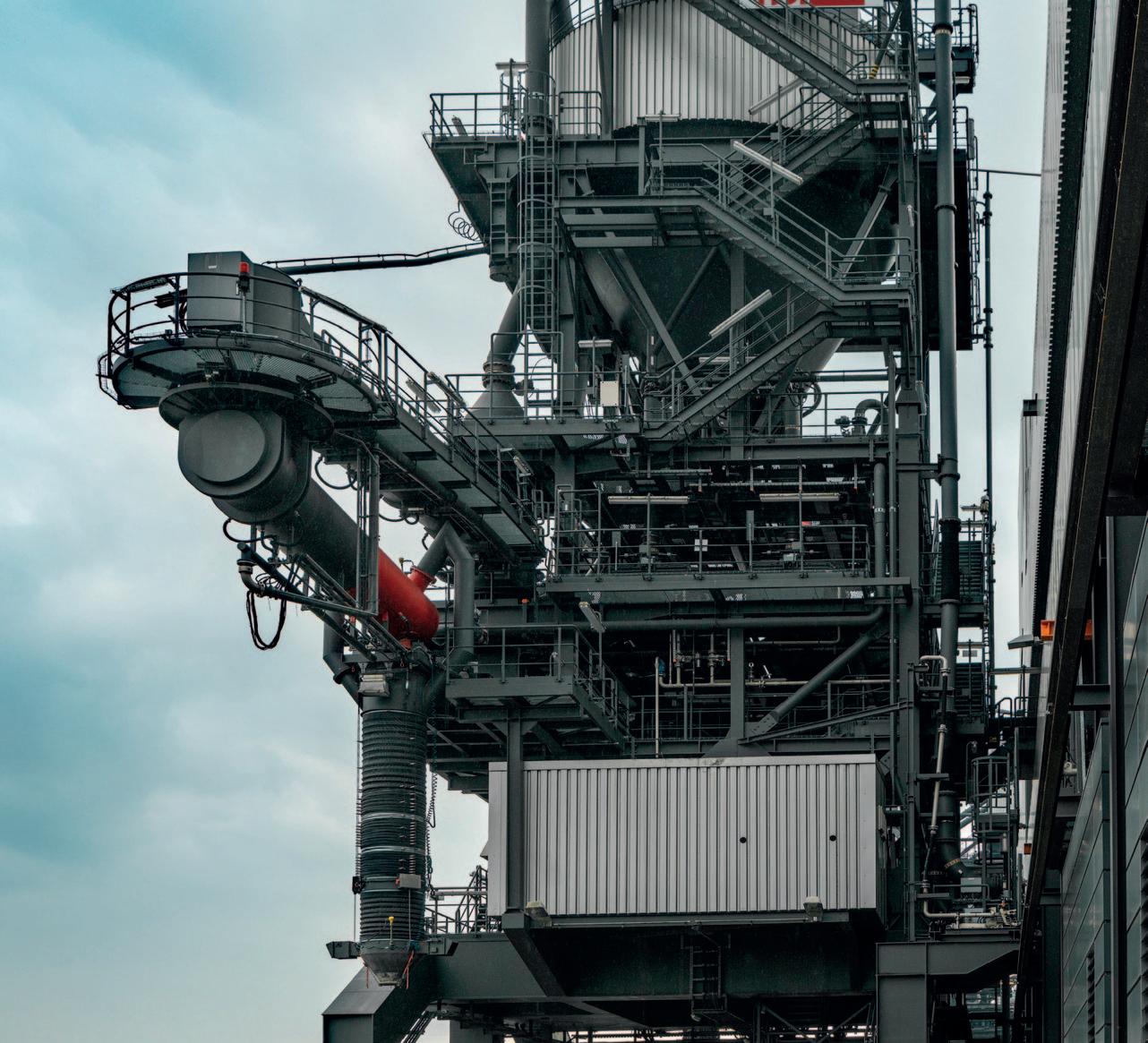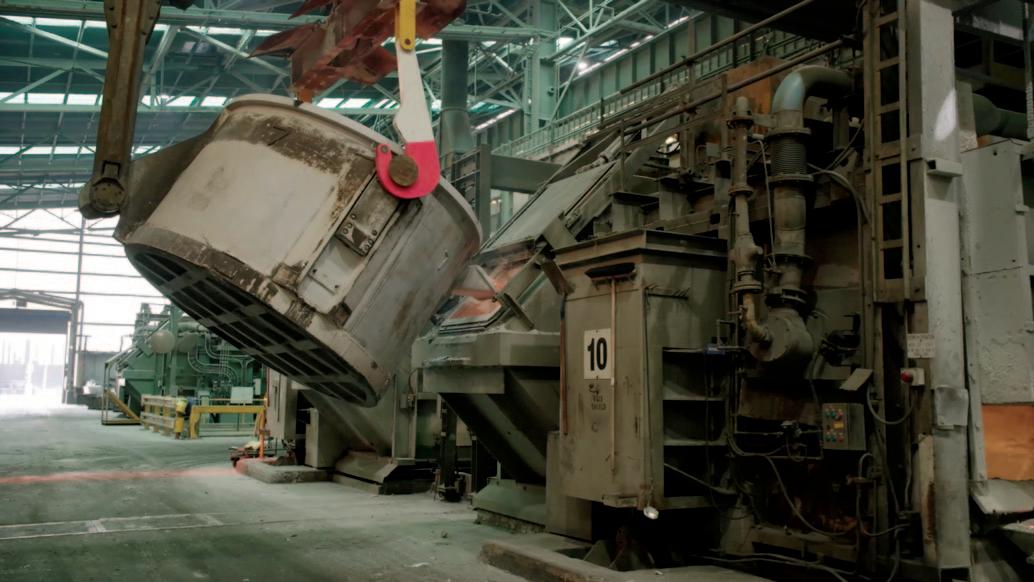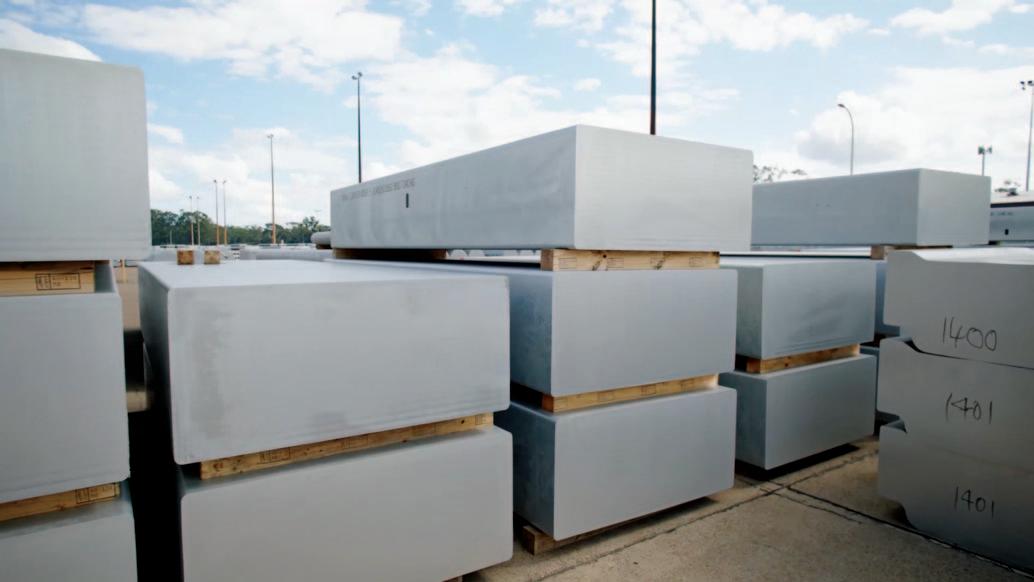
9 minute read
material limits
Nothing should stand in the way of your productivity – least of all the materials you move. With our compact Hägglunds direct drive systems, you can adapt easily to the job at hand, taking advantage of full torque at an in昀nite range of speeds. And should an overload try to stop you, the drives’ low moment of inertia and quick response will keep your machines protected. We’ll support you too, with an agile global network and smart connectivity to bring you peace of mind. Driven to the core.
Hägglunds is a brand of Rexroth. www.hagglunds.com
A developing phenomenon in China is that, as the country continues to give a push to building new alumina capacity and step up production of the chemical in the face of declining quality of domestic ore and growing uncertainties of outsourcing the material to countries like Indonesia disinclined to part with bauxite to which much value can be added locally, it will aggressively remain in search of new deposits overseas. No wonder all this presents Guinea in particular and a few other resource-rich countries with the opportunity to develop new bauxite mines.
China will only be too keen to make further large investments in bauxite mines opening and infrastructure development by way of building roads and rail transportation to facilitate mineral evacuation from mine sites to ports. Bauxite mining will continue to boom in Guinea, one of the world’s poorest countries in the wake of forecast that the global demand for aluminium will take a 40% leap to 119.5mt tonnes by 2030. Impressive demand rises for the white metal will occur on the back of greater application in traditional areas such as construction and packaging and surge in use in new age electrical vehicles and photovoltaic sector.
But with rapid expansion of bauxite mining since the beginning of the new millennium, the time has come for introspection of its impact on the environment and livelihood of people in action centres. Guinean official sources are quoted saying hundreds of square miles once used for farming have been acquired by mining companies. The inevitability of that is beyond question, for, according to International Monetary Fund, mining accounted for 84% of the country’s total exports and 21% of its GDP in 2021. But what is of concern is that villagers who gave away their land for bauxite extraction got “a pittance” from miners. As if this were not enough, emission of thick layers of dust during mining and bauxite transportation by trucks from mines to ports is playing havoc with growing of crops such as corn, egg plant and cashew. The income of fishermen has dwindled with bauxite barges chasing away once-plentiful fish. In many cases jobs promised by miners ahead of land acquisition did not materialize. The quality of water, in any case in short supply, has fallen around the operating mines. Guinean officials are concerned that, unless preventive steps are taken now and mining groups are made to fall in line, the country will be staring at the prospect of more than 200,000 acres of farmland and 1.1m acres of natural habitat being destroyed by bauxite mining.
Sharma, a veteran campaigner for safe and environment friendly mining says: “The world is increasingly inclined to use aluminium for light weighting of all transport systems and in other sectors for its environment friendliness. Aluminium lends itself to recycling again and again without any loss of quality. We have it from International Aluminium Institute that every year over 30mt of aluminium scrap is recycled globally, making the silvery white metal one of the most recycled materials on the planet. Moreover, scrap recycling uses about 5% of the energy required to make virgin aluminium starting from bauxite excavation. China has come close to its self-capped aluminium smelting capacity of 45.5mt. Whatever that may be, the world will need an additional 33.3mt to meet demand growth in all industrial sectors from 86.2mt in 2020 to 119.5mt in 2030.” Assuming that Beijing will stick to the capacity cap, the required incremental production will have to happen in the UAE, Bahrain, which boasts of the largest singlesite smelter in the world, Indonesia (driven by resource nationalism), India endowed with plentiful deposits of bauxite and coal, Russia and Canada.
Virgin metal apart, aluminium companies around the world — in their drive to cut emissions — are committed to recycle growing volumes of scrap metal. The lead here comes from the US Atlanta-based Novelis, a 100% subsidiary of India’s Hindalco Industries. Novelis claims “we recycle more aluminium than anyone in the world — 2.2mt per year. We have invested more than $1.1bn since 2011 to expand our recycling capacity, alongside our efforts to decarbonize primary aluminium production... At the same time, we are number one in operational aluminium closed-loop-recycling systems, returning the production scrap from our automobile customers back to our facilities for recycling. We will continue to play a key part in enabling the transition to a more circular and sustainable future.” More and more of those engaged in making primary metal have started walking the path that will lead to net-zero carbon emissions by mid-century.

Aluminium pioneer Alcoa, for example, has increased its percentage of electricity derived from sustainable sources to 86 and reduced its carbon dioxide emissions by 4.6 during 2022. The company also grew its sales of the proprietary blend of lowcarbon Sustana line of products last year. Sustana sales helped customers in reaching their own sustainability goals.

Unarguably the industry’s most environment-conscious Norsk Hydro, on its part, has in place “‘three main pathways’ to deliver industrial-scale zero carbon aluminium by 2030. These are: recycling of post-consumer scrap v through decarbonized operations; carbon capture and storage for v existing smelters; and development of Hydro’s proprietary v HalZero technology for greenfield smelters.
Since 1990, Hydro has cut emissions by 55% and the CO2 footprint in aluminium products by 70% at its fully owned primary metal smelters. Hydro claims its breakthrough technology HAL4e has cut energy consumption by as much as 15%. The global aluminium industry’s progress to net zero emission will, however, depend much on steps taken by smelters and refineries in China which with respective capacity of 96.75mt and 44.48mt to make their operations as pollution free as possible. Incidentally, aluminium makers make significant contribution to China’s carbon footprint, making up around 5% of the country’s total emissions.
A Delhi-based analyst says: “Chinese aluminium production in 2022 was up 4.5% to a record 40.21mt, and this is likely to rise further to 42.44mt this year. Dominance of China is underpinned by the fact that global primary metal production was 68.417mt in 2022. But in the process of making this volume of white metal based largely on coal-fired electricity to the extent of around 75%, China’s would also produce a volume of carbon dioxide, which is greater than total Indonesian emissions. Thankfully, the process of building and relocation of smelters and also refineries to southwestern provinces such as Sichuan and Yunnan, which have maximum hydroelectric capacity among all provinces, began quite some time ago. Attempts are also being made to harness other renewable capacity. Beijing should also motivate the industry to go for higher and higher rates of recycling of scrap. A big amount of scrap now goes into landfill, harming the environment.” Incidentally, about 19% of Chinese smelting is done using hydropower.
The global transition to a lower carbon economy will favour the use of aluminium, including substitution of steel in some areas, particularly in transport and construction. Aluminium scores over steel on at least four grounds: weight to strength ratio, malleability, lower thermal conductivity and higher resistance to corrosion. No wonder then, a study done recently by CRU International on behalf of International Aluminium Institute has projected an almost 40% rise in aluminium demand in ten years to 2030. Transportation, construction, packaging and electrical sectors accounting for 75% of metal use will all drive demand in future, requiring new large investments in the industry. While these four sectors will principally drive demand, two-thirds of demand growth (12.3mt) will likely materialize in China, the rest of Asia 8.6mt, North America 5.1mt and Europe 4.8mt. The four regions then will have a share of 90% of incremental global demand for aluminium during 2020–30, says the report. Incidentally, more and more countries pushing reforms relating to decarbonization and vehicles powered by renewable energy instead of fossil fuels will see production of EVs rising to 31.7m units in 2030 from 19.9m units in 2020. Automobile industry officials say the average use of aluminium in EVs will be 250kg upwards.
It is a given that much of the incremental demand for the white metal will be met by production of primary aluminium through building of new smelting capacity. This will correspondingly require opening of new bauxite mines and expansion of refineries through brownfield and greenfield routes. A research report published earlier this year by Spherical Insights & Consulting says the global alumina market will advance to $46.53bn by 2030 from $30bn in 2021 at a CAGR of 5%. At the same time another market survey by Precedence Research projects global alumina market size to grow at a CAGR of 5.89% to $72bn by 2030 from $43bn in 2021. The big difference in estimating global alumina market size and also rate of growth by the two agencies is quite intriguing. However, there is unanimity that Asia Pacific will remain the largest market for the chemical while future capacity growth will be fastest in North America and Asia Pacific. falling quality in Chinese ore and growing pressure brought to bear upon Beijing by Indonesia and Guinea (the major suppliers of ore) to create value there by building refineries and smelters will shape future China driven capacity growth. Consider soon after fully commissioning a 2mt refinery at Galang Batang special economic zone on Bintan Island in Indonesia, China’s Shandong Nanshan has started pursuing investment of $6bn in a smelter complex. There, capacity will be built in phases starting with 250,000 tonnes — work to start around this year-end — to finally 1mt. The refinery based on Nanshan process gets bauxite from Kalimantan region. The proposed smelter will be designed to make very high quality ingots for use in aircraft and EVs. Chinese company owned refineries in Indonesia have been growing in capacity for quite some time. Now in May a China owned smelter in Indonesia’s Sulawesi island got commissioned with ambitious target to finally become a 2mt capacity complex. The smelter project is a joint venture between chemical producer Huafon and Tingshan. Local value addition related pressure apart, Jakarta has on offer an attractive basket of incentives, including tax breaks. For example, Shandon Nanshan, whose investment in refinery cum smelter ranks among the major foreign direct investment in Indonesia, has been given a 21 year income tax waiver. to create 11mt of alumina refining capacity in Guinea. But to the regime’s disappointment, while self-interest-driven miners continue to make good progress in mine development and are lifting bauxite production at regular intervals, they are found wanting in making similar progress in building refineries even after making investment commitments.
Let’s consider China first which will be growing alumina capacity more outside the country than within. Domestically, around 3.5mt of new alumina refining capacity was scheduled for commissioning in this year’s first half, of which 2.4mt of capacity is now being ramped up. The Guangxi region and Hebei are having a major share of the newly commissioned refining capacity with 1.2mt each. China’s overseas alumina profile is becoming increasingly big, not little because of growing pressure of major bauxite owning countries such as Guinea and Indonesia to produce alumina there. That country’s overseas alumina capacity is 5.56mt. This will further rise by 10mt planned for Guinea and another 4mt for Indonesia.

A notable feature of alumina manufacturing in China is that refineries built over the past decade are very large in size, giving benefits of economies of scale and logistical benefits. Of the 44 refineries in operation in the country, as many as 20 have capacity of more than 2mt. A SMM report says since 2013, China’s alumina production grew at a CAGR of 5.8% from 46.53mt to 77.68mt in 2022. China’s search for carbon neutrality has seen aluminium and in the upstream alumina makers showing interest in building smelters and alumina refineries in the country’s south and southwest based on hydroelectricity. The recent months have witnessed growing gaps in alumina prices in China’s northern and southern regions leading to transfer of the chemical from Guangxi and Gaizhou to northern regions.
In the meantime, the military junta of Guinea wants foreign groups engaged in bauxite mining to submit firm proposals for building alumina refineries to beef up revenues for the government from the resource and also create employment.
Anthony Everiss, a senior analyst with CRU Group has made this pertinent observation in the context of evolving junta firm stand: “The message to the international mining community in recent times is that Guinea is now much more aware of the value of their resources, has better control and understanding of the mining industry and exports, and would be ensuring a more equitable share of the revenue and profits from international mining endeavours. This was coupled with a focus on social inclusion, agriculture, infrastructure spending and sustainability.”
It is seen in the case of Indonesia, big importers of bauxite respecting local aspirations and nudged by the authorities continue to make investment in alumina making on a significant scale. In all likelihood, Guinea, if it stands its ground will similarly see bauxite producers going for local refining of the mineral. Perhaps some will go further forward to smelt the chemical into white metal as it is happening in Indonesia. GAC and Aluminium Corporation of China (Chalco) have signed a collaboration agreement to build an alumina refinery in Guinea making use of the refining expertise available with the two. In course of time, both Indonesia and Guinea hold the promise of becoming










